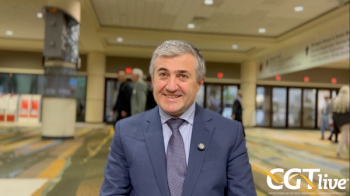
FDA Grants JCAR017 Breakthrough Designation for Non-Hodgkin Lymphoma
JCAR017 has received an FDA breakthrough therapy designation for the treatment of patients with relapsed/refractory, aggressive large B-cell non-Hodgkin lymphoma.
Mark J. Gilbert, MD
JCAR017 has received an FDA breakthrough therapy designation for the treatment of patients with relapsed/refractory, aggressive large B-cell non-Hodgkin lymphoma (NHL), according to Juno and Celgene, the codevelopers of the CD19-targeted CAR T-cell therapy.
The designation is specifically for patients with diffuse large B-cell lymphoma (DLBCL), primary mediastinal B-cell lymphoma, grade 3B follicular lymphoma, or not otherwise specified disease (de novo or transformed from indolent lymphoma). Breakthrough therapy designation is meant to expedite the development of promising medications that have shown preliminary signs of clinical efficacy, typically in phase I or II trials. Under the program, the FDA will be more accessible, in order to provide advice on the design and conduct of the clinical development program.
The companies also reported that the European Medicines Agency’s (EMA) Committee for Medicinal Products for Human Use and Committee for Advanced Therapies granted JCAR017 access to the Priority Medicines (PRIME) scheme for relapsed/refractory DLBCL.
“The breakthrough therapy designation from the FDA and PRIME eligibility from EMA for JCAR017 highlight the need for new treatment options for patients with DLBCL, particularly for the significant number of patients who do not respond to initial therapy or with relapsed disease,” Mark J. Gilbert, MD, Juno’s chief medical officer, said in a statement. “Early data with JCAR017 in a range of B-cell malignancies have been encouraging and we look forward to initiating a pivotal trial in patients with relapsed or refractory DLBCL in the United States in 2017.”
JCAR017 demonstrated a 60% complete response (CR) rate in patients with relapsed or refractory CD19-positive NHL in findings from the multicenter, phase I TRANSCEND study presented at the 2016 ASH Annual Meeting.
The study administered JCAR017 at various doses to patients with DLBCL, grade 3b follicular lymphoma, and mantle cell lymphoma (MCL). The overall response rate (ORR) with the lowest dose of the therapy was 80%. CRs were seen in patients with double- and triple-hit lymphoma and for 1 patient with CNS disease. After 3 months of follow-up, 42% of assessable patients remained in response.
There were fewer adverse events (AEs) seen with JCAR017 compared with other CD19-targeted CAR T-cell therapies. None of the enrolled patients experienced severe cytokine release syndrome (CRS). Thirty-six percent of patients had grade 1/2 CRS and just 1 participant required treatment with tocilizumab. Additionally, 5 patients (14%) had severe neurotoxicity, all of which resolved with treatment.
In the phase I study, patients underwent leukapheresis at study entry for the manufacturing of the CAR T cells. Prior to JCAR017 infusion, patients received lymphodepleting chemotherapy with fludarabine (30 mg/m2) and cyclophosphamide (300 mg/m2) daily for 3 days. A modified continual reassessment method was utilized to determine CAR T cell dose level (DL), to avoid potential AEs. Three DLs were utilized: 5 x 107 cells (DL1), 1 x 108 cells (DL2), and 1.5 x 108 cells (DL3).
The median age of patients was 63 years, and NHL subtypes included DLBCL (n = 15), transformed DLBCL (n = 10), MCL (n = 2), and follicular grade 3b (n = 1). Eighty-six percent of patients were refractory to their last therapy and 82% were chemorefractory. Patients had ECOG performance statuses of 0 (50%), 1 (36%), and 2 (14%).
Patients had received a median of 4 prior therapies (range, 1-8), and a quarter had received ≥5 prior lines of therapy. Overall, 57% of patients received stem cell transplants, which were allogeneic (14%) and autologous (46%).
In a small cohort of patients with DLBCL treated with a double dose at DL1 (n = 3), the ORR was 67%. One of 2 patients with MCL responded to a single-dose of DL1. Additionally, 2 patients received a single dose of DL2, which elicited a CR rate of 100%. Furthermore, assessment of safety with DL2 did not reveal severe CRS or grade 3/4 neurotoxicity.
The most common all-grade treatment-emergent AEs across all patients and dose (N = 28) were fatigue (39%), CRS (36%), decreased appetite (29%), constipation (25%), vomiting (25%), diarrhea (21%), dizziness (21%), headache (18%), hypertension (18%), nausea (18%), and peripheral edema (18%). There was 1 grade 5 respiratory failure in a patient with MCL who progressed on JCAR017 and had begun subsequent therapy. This was deemed to be potentially related to JCAR017.
Four patients required treatment with dexamethasone and 1 received tocilizumab. No patients were treated with vasopressors and anti-epileptics were initiated for 1 patient with CNS lymphoma and for 5 experiencing neurotoxicity symptoms.
“The encouraging news of the FDA breakthrough therapy and EMA PRIME designations reflect the agencies’ emphasis on accelerating the development and assessment of potential new options for serious blood cancers like DLBCL,” Jay Backstrom, MD, chief medical officer and head of Global Regulatory Affairs for Celgene, said in a statement. “We will continue to work closely with our partners at Juno and with the agencies to move the JCAR017 program forward in the interest of patients with relapsed or refractory DLBCL.”
Abramson JS, Palomba L, Gordon LI, et al. Transcend NHL 001: immunotherapy with the CD19-directed CAR T-cell product JCAR017 results in high complete response rates in relapsed or refractory b-cell non-Hodgkin lymphoma. Presented at: 58th American Society of Hematology Annual Meeting; San Diego, CA; December 3-6, 2016. Abstract 4192.
In 27 efficacy evaluable patients treated across doses, the ORR was 78%, with a CR rate of 52%. Those with chemorefractory DLBCL (n = 16) had an ORR of 75%, which included a CR rate of 56%. Overall, 2 patients had double-hit, 3 had triple-hit, and 4 had double-expresser DLBCL. Within this group of 9 patients with aggressive subtypes, there were 7 CRs and 2 PRs.
Newsletter
Stay at the forefront of cutting-edge science with CGT—your direct line to expert insights, breakthrough data, and real-time coverage of the latest advancements in cell and gene therapy.

















































